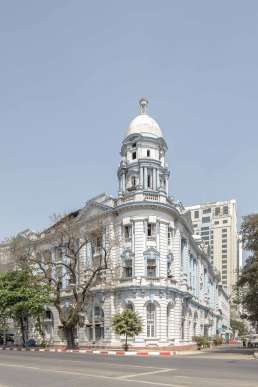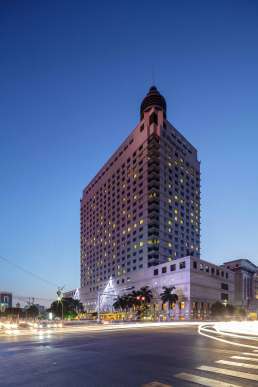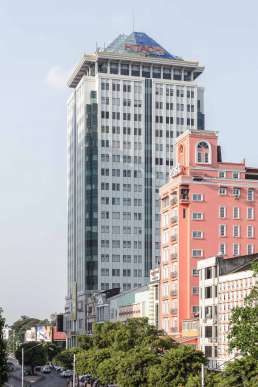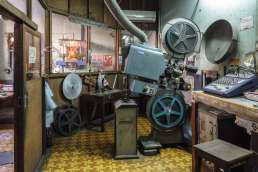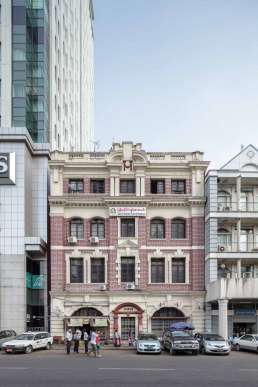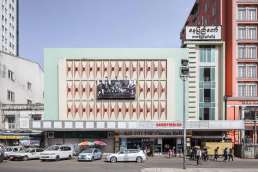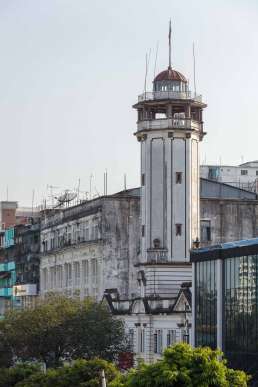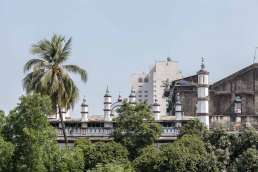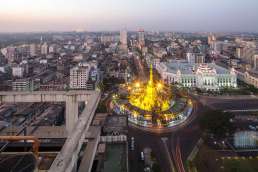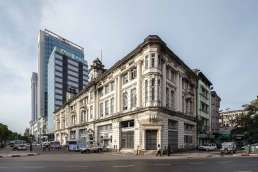Myanmar Economic Bank Branch 3
Formerly: Bank of Bengal and Imperial Bank of India
Address: 15-19 Sule Pagoda Road
Year built: 1914
Architect: Unknown
This building was recently repainted in white and blue—clearly the colours of choice for the MEB’s historic branches in Yangon. The historical accuracy of the renovations are dubious, which adds to the building’s extravagance. Tall Ionic columns connect the top two floors. An imposing corner tower overlooks Strand Road. There are numerous pediment designs above the windows, some triangular, others semicircular. The same patterns also feature in the arches at the top. The main arch, above the main entrance on Sule Pagoda Road, is rounded; a corporate insignia probably adorned this space once. Balustrades line some of the windows and the edges of the roof. A closer look at the building reveals a superficial paint job: the weeds on the tower have not been cleared away, nor did painters see to the building’s side and back which are still in its previous yellow coating. Note the small annex building between the main building and the First Private Bank next door.
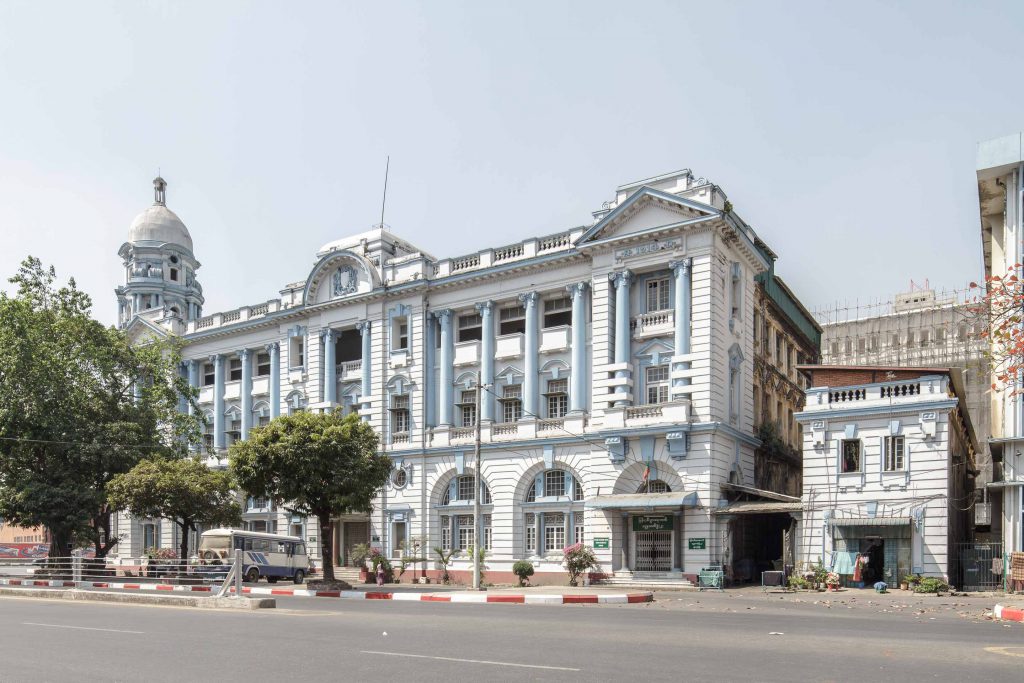
The Bank of Bengal became the Imperial Bank of India after a merger in 1921. In his fantastic book on the history of the Burmese banking sector, Fiery Dragons, Sean Turnell writes that the Imperial Bank was by far the most important bank in colonial Burma. It took on central bank-like features during much of the period before independence. For example, it provided the system for clearing cheques. It also offered commercial lending, particularly to the Chettiar community, who in turn provided funds to much of Burma’s agricultural sector. The bank was renamed the State Bank of India after independence and operated on a much smaller scale after the war. It was nationalised in 1963 and became “People’s Bank No. 8”.
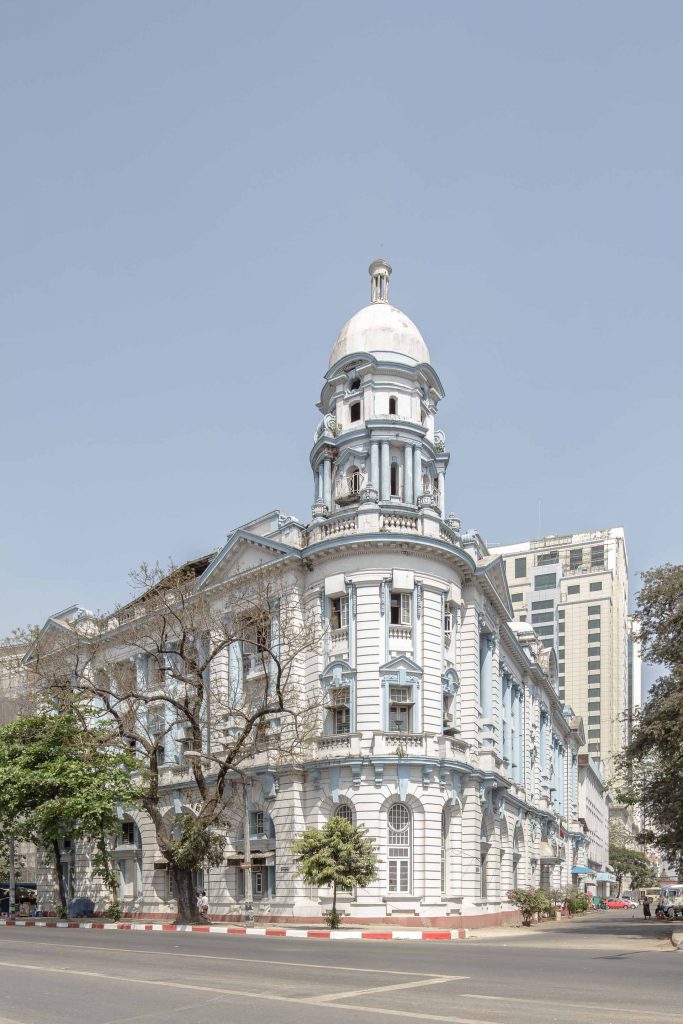
Unlike the parts of Strand Road by the General Post Office or the Strand Hotel, this is a quieter stretch. However, a major hotel construction at the Division Office Complex might change this dynamic. To make this section of the Strand more inviting, the architects should make the most of the building’s pedestrian arcade.
Sule Shangri-La
Formerly: Traders Hotel
Address: 223 Sule Pagoda Road
Year built: 1996
Architect: RSP Architects and Planners Co. Ltd and Kanko Kikaku Sekkeisha
To many Yangon residents this hotel will remain the Traders for some time, although the new name is slowly taking hold. (If cab drivers don’t recognise one name, try the other.) Japanese firm KKS drew the designs together with Singapore-based RSP. RSP stands for none other than Raglan Squire & Partners. The British architect left his mark on Yangon in the 1950s and set up an office in Singapore thereafter. (See the Technical High School and the University of Medicine-1 for his two works.)
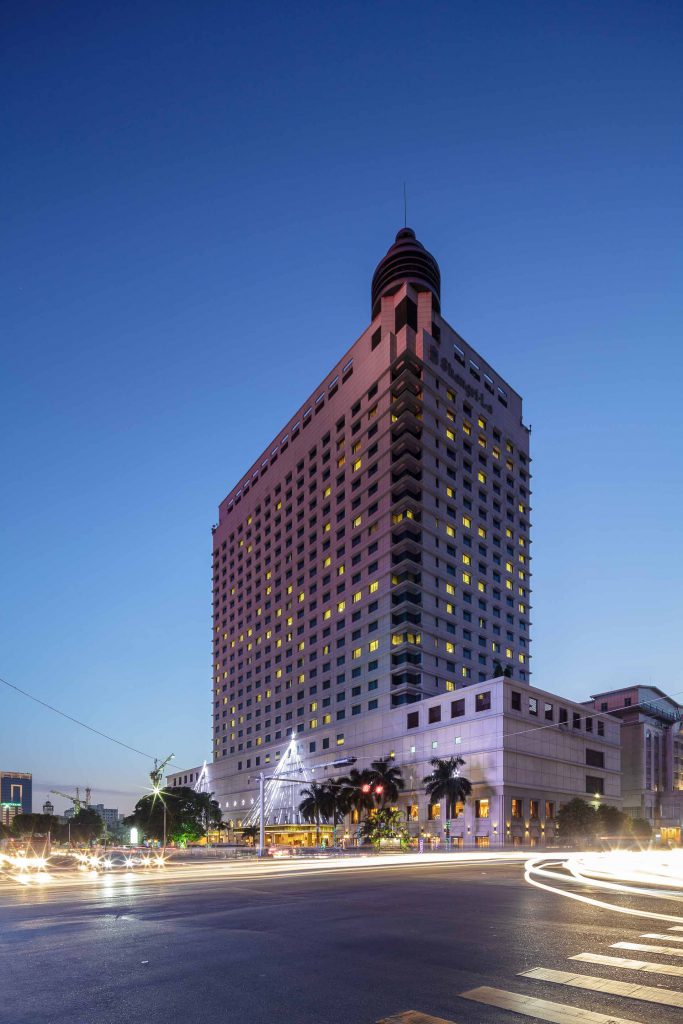
One wonders what Mr Squire would think of the Traders: a nondescript tower block with many lookalikes across Asia. Thankfully, its slender width reduces the building’s visual impact on the skyline when seen from the south. The large, round tower on the corner of Bogyoke Road only serves a decorative purpose. The Traders’ four-storey base is almost windowless, making the building somewhat ominous from up close. The hotel has almost 500 rooms and a large selection of meeting and function rooms. These are named after the country’s former kingdoms.
The Traders was part of the junta’s plan to transform the country into a tourist destination. As the international community began to boycott Myanmar, however, the Traders was very quiet indeed. The fallout of the Asian financial crisis in 1997 also took its toll. Rooms sold at a fraction of today’s soaring rates and, ironically, UN agencies and NGOs were able to set up offices there as a consequence. Guests getting off on the wrong floor would find armed soldiers in blue berets. (The sight of busy humanitarian aid offices with thick carpet and en-suite bathrooms was also unusual.)
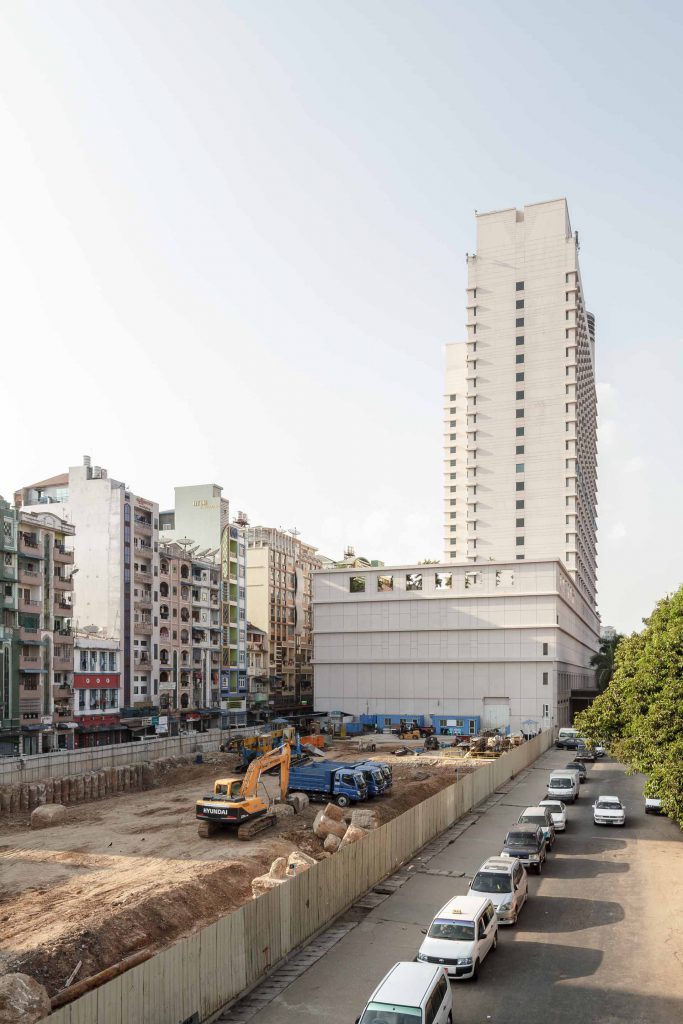
The hotel stands on what was once “Cinema Row”. Two theatres from the colonial days, the Palladium and the Globe, were torn down to make way for the building. (Cinema enthusiasts should stroll one minute away to admire the still-standing Waziya from that period.) An Armenian cemetery also stood nearby. It was moved to make way for a park, which is now the construction site for Sule Square, a planned 20-storey office complex. The tower will mimic its neighbour with a base similar in height. It will house retail space and overground car parking. One can only hope that this project will provide an occasion to improve pedestrian accessibility of the pavement on Sule Pagoda Road.
The Traders was a joint venture between Kuok Singapore Limited and the notorious Lo Hsing Han, a man widely accused in the West of masterminding Burma’s opium trafficking networks. He passed away in 2013. His son Steven Law leads their conglomerate which includes hotels, supermarkets, sea ports and Mandalay Beer.
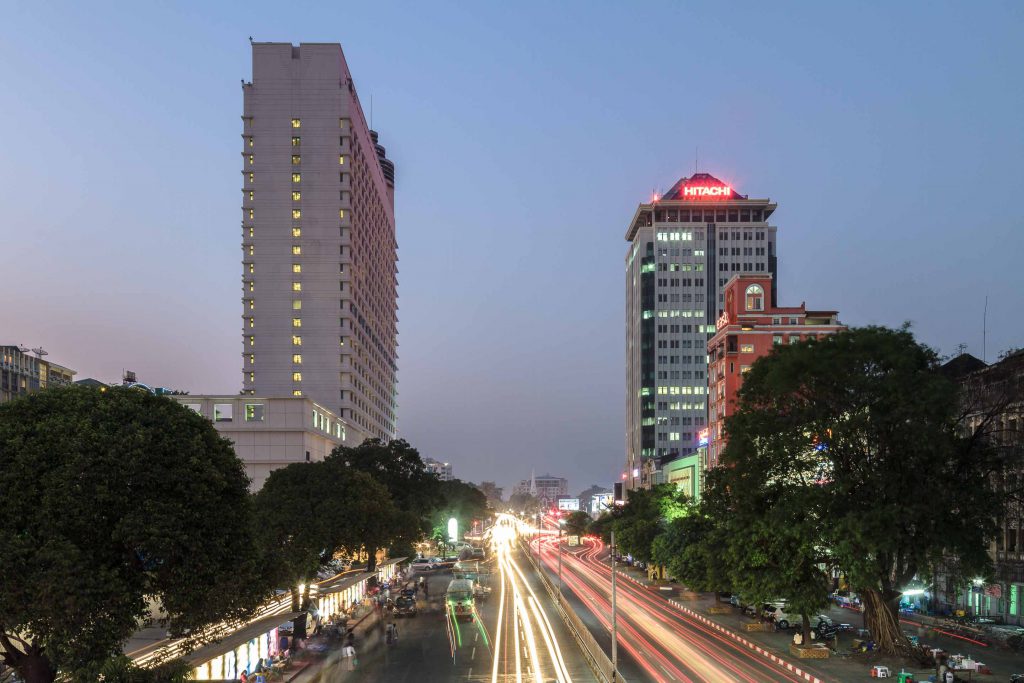
The Traders lobby is the most common professional meeting place in the city, especially for expats. Business people, UN officials and journalists eye each other knowingly as they slalom past tourists in the large atrium.
In October 2013 a bomb exploded on the ninth floor, in the lead-up to Myanmar hosting its first Southeast Asian Games (often referred to as the SEA Games) in 44 years. The attack injured an American tourist. Several more bombs detonated throughout the country. One month later, authorities arrested three men from Rakhine State. Their reported aim was to target mosques and Western venues.
Sakura Tower
Address: 339 Bogyoke Road
Year built: 1999
Architect: Nihon Sekkei, Inc.
The Sakura Tower is almost exclusively a Japanese affair, starting with the name. Financed by a Japanese investor, it was designed by Nihon Sekkei and built by Konoike, both Japanese firms. Mitsubishi and Hitachi elevators transport people up and down the 20 floors, and a large and lit Hitachi logo adorns the building’s slanted roof structure. In a nod to Japanese expertise, the tower is also earthquake-resistant. Its East Asian pagoda-like roof and recessed top floor are iconic in Yangon’s skyline.
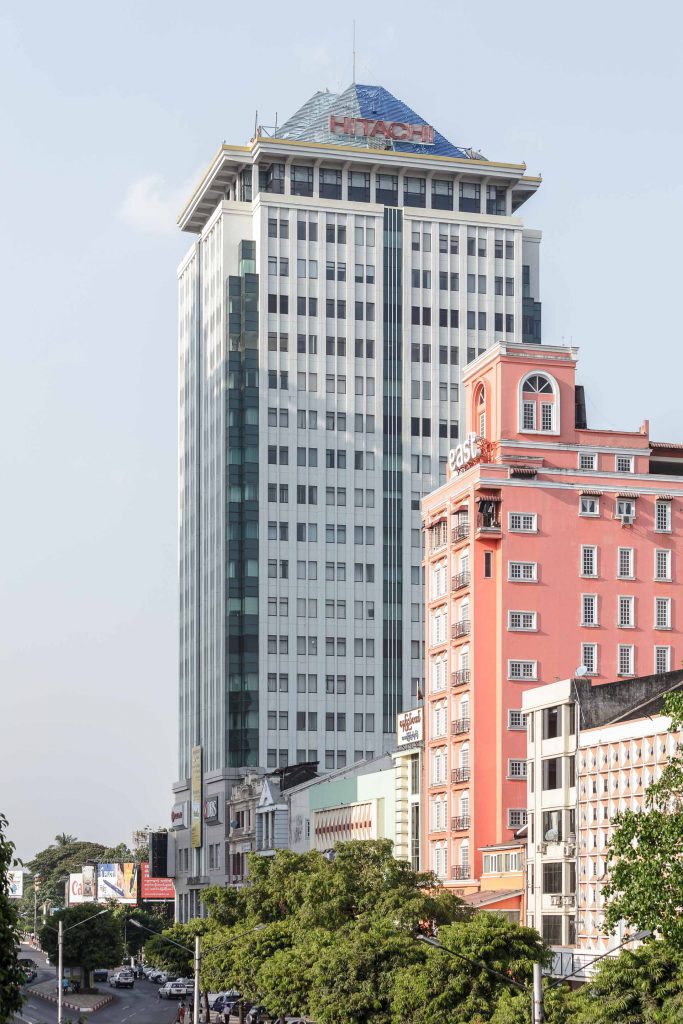
Built a few years after the Sule Shangri-La across the street, and like most 1990s real estate developments in Yangon, the Sakura Tower battled with high vacancy rates in its early years. In fact low demand for its office space meant the Sakura Tower had to mothball some of the upper floors. Quite the opposite is true today. The building is totally full and one of the few office spaces in Yangon up to international standards. (It has 24-hour generator electricity backup, no small luxury in a blackout-prone city.) Tenants include the Japanese aid agency, JICA, as well as Japanese companies such as Itochu Corporation, Mitsubishi Corporation and Sompo Japan Insurance. A restaurant on the 20th floor offers a breathtaking perspective of the city. This valuable space could do with a renovation, though. The slightly kitsch interior is one thing. It would also gain from adding an open-air balcony where customers could fully absorb the exceptional view.
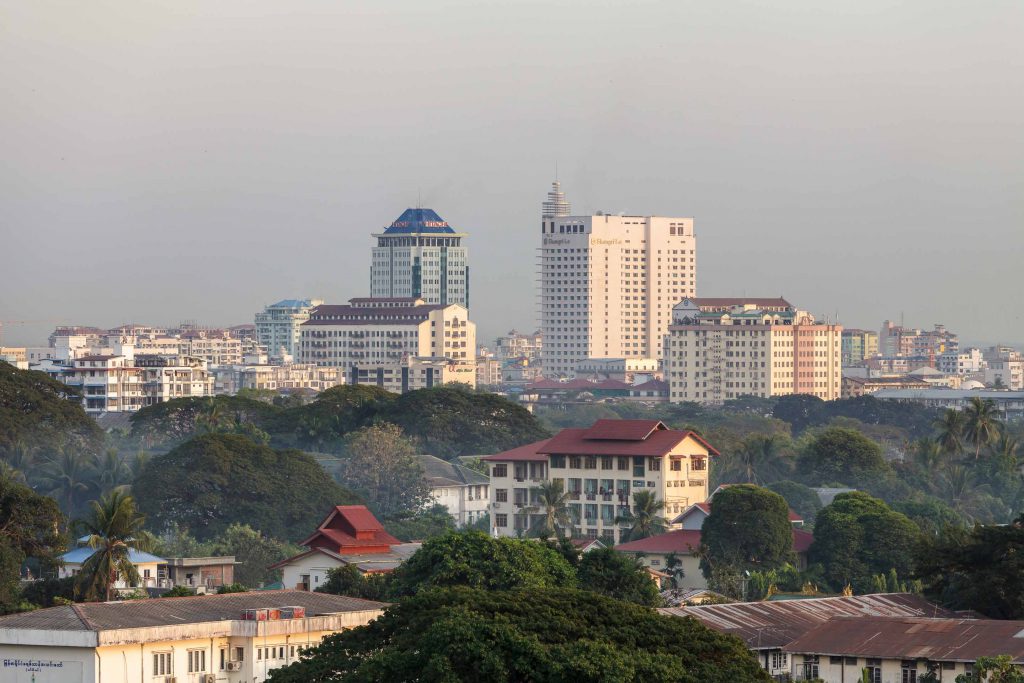
As mentioned elsewhere in this guide, this stretch of Bogyoke Road was once colonial Rangoon’s entertainment centre, “Cinema Row”, lined with many movie houses. The Sakura Tower replaced the Ritz cinema, also known as the Majestic. The only surviving cinema from the colonial period is the next-door Waziya on Bogyoke Road. The area hosts several more recent movie theatres, including the Nay Pyi Taw and Shae Saung cinemas down the street, on Sule Pagoda Road.
Waziya Cinema
Formerly: New Excelsior Theatre
Address: 327/329 Bogyoke Road
Year built: 1920s
Architect: Unknown
The Waziya Cinema (or the Excelsior, as it was known) is the last remnant of what was once “Cinema Row”, an iconic strip of movie theatres opposite the Central Railway Station. Thankfully, it is also the oldest and finest example of that period. A minute’s walk from the Sule Shangri-La, right past the Sakura Tower, you won’t miss this majestic, cream-coloured building built deep into 33rd and 34th Streets. Traffic permitting, you may want to cross the street to admire it properly.
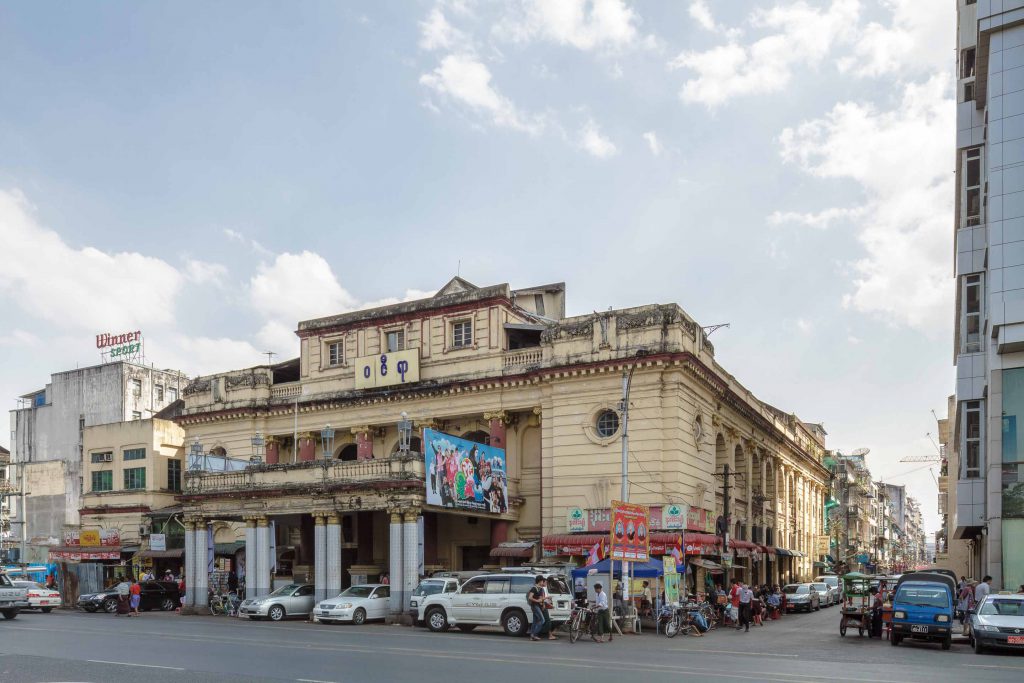
Between its imposing white and gilded Ionic columns hang movie posters for the latest Burmese films. The large space beneath the portico (itself a later addition to the building) always teems with hawkers, betel nut stalls and customers awaiting the next screening. Along the roof of the portico—doubling up as a terrace on the first floor—a second row of columns flanks three open-air arcades. This leads to a holding area outside the main hall, lined with tired-looking leather folding seats. The ground floor lobby features original, if worn, teak panelling and the doors to the screening room are the grandest you are ever likely to find in any cinema.
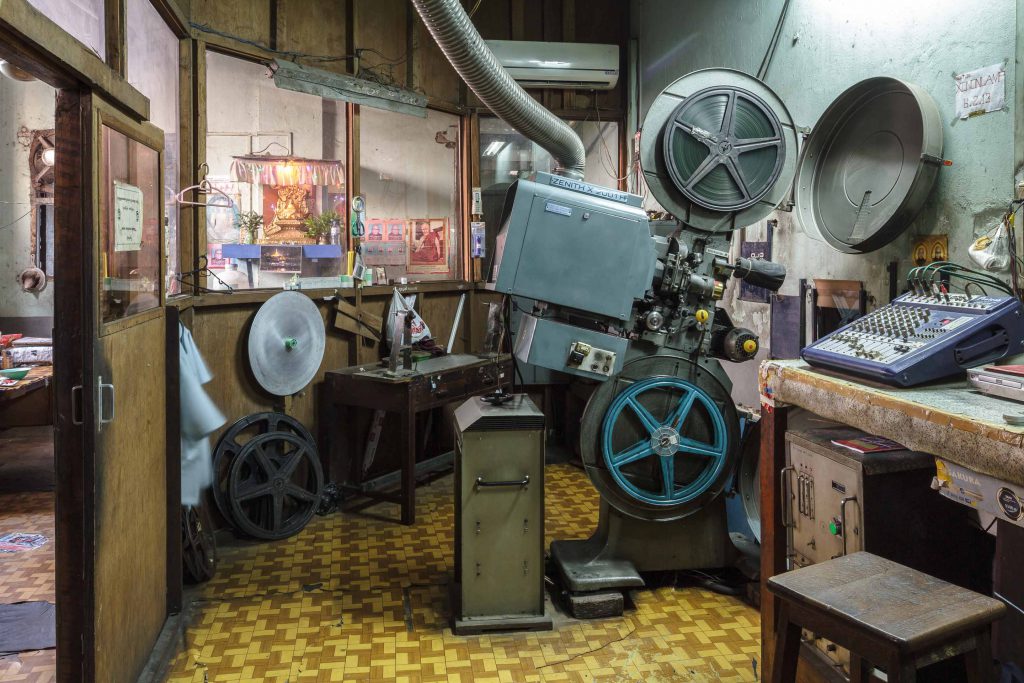
The Excelsior was nationalised and became the Waziya in 1964. Built as a live theatre, the government returned it to its original use in 1985. In 1999 it became a cinema again. The Ministry of Information leased it to the Myanmar Motion Picture Organization (MMPO). Owing to its location and beauty, a restoration proposal by the Yangon Heritage Trust and the MMPO may offer the Waziya yet another lease of life. They aim to convert it into a thriving entertainment and cultural centre, complete with state-of-the-art digital AV equipment.
Until then, you can still enjoy the whirring sounds of the old projector spinning its way through reels and reels of Burmese movies—as it did once with those of Alfred Hitchcock, Elvis Presley and Marlon Brando.
The Bible Society of Myanmar
Formerly: British and Foreign Bible Society
Address: 262 Sule Pagoda Road
Year built: 1910
Architect: Robinson & Mundy
This red brick building became the heart of Christian evangelical efforts in the early 20th century. Being four storeys in height, it reveals the average scale of buildings in the city at the time—and until recently. Although the adjacent Sakura Tower dwarfs it today, the building still stands out thanks to its good condition and simple, graceful form.
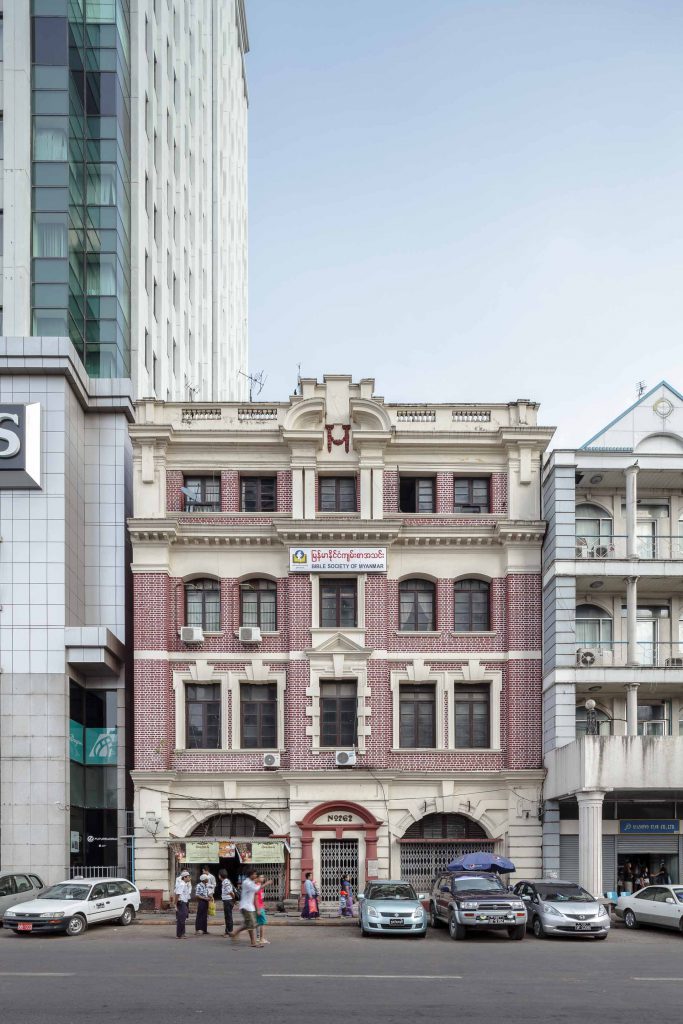
Robinson & Mundy were the architects and contractors in charge. Their imprint on Yangon is considerable: they also built the British Embassy, the former Myanma Oil and Gas Enterprise Building and Ayeyarwady Bank, as well as the large functional transit sheds at Sule Pagoda Wharf. The latter still dominate the view from the riverside.
After Ne Win took power in 1962, foreign missionaries were expelled from the country. In 1964, the Bible Society was reorganised under national leadership. Today it still oversees the dissemination and translation of Christian holy texts into the country’s myriad ethnic languages. Today the Bible (or portions thereof) exists in 71 of Myanmar’s languages.
It all began with an American Protestant missionary named Adoniram Judson. He translated the entire Bible into Burmese and published it in 1835. By that time he had spent more than two decades in the country and mastered the language so well that his translation remains the most popular to this day. When he arrived there were no Protestants in the country; it was several years before he was able to perform his first baptism in 1819. Yet upon his death in 1850 there were as many as 8,000 faithfuls and about 100 Protestant churches around the country. Today about 4 per cent of Myanmar’s population is Christian, and three quarters of those Protestant. Most of them belong to the country’s ethnic minorities such as the Chin, Kachin, Karen and Lisu.
Nay Pyi Taw Theatre & Shae Saung Cinema
Nay Pyi Taw Theatre
Address: 242/248 Sule Pagoda Road
Year built: Circa 1960/61
Architect: Unknown
Shae Saung Cinema (formerly: Lighthouse Cinema)
Address: 198/200 Sule Pagoda Road
Year built: Unknown
Architect: Unknown
One long-time Yangon resident constulted for this book dates the Nay Pyi Taw Theatre’s construction to 1960 or 1961. After 1962, the cinema was leased to the Chinese Embassy and you could only watch Chinese films there for a time. The Shae Saung, a few doors down the street, seems to be roughly from the same period. The cinemas’ patterned façades evoke late 1950s and early 1960s design, which you also find in Thai and Cambodian cinemas from that era. These were usually private ventures by local businessmen riding a climate of post-independence optimism. In that sense, the architecture is clearly forward-looking and, you might say, self-consciously post-colonial. (On the other hand the entrance marquees—a 1930s invention in the West—give the entrances a certain vintage feel.)
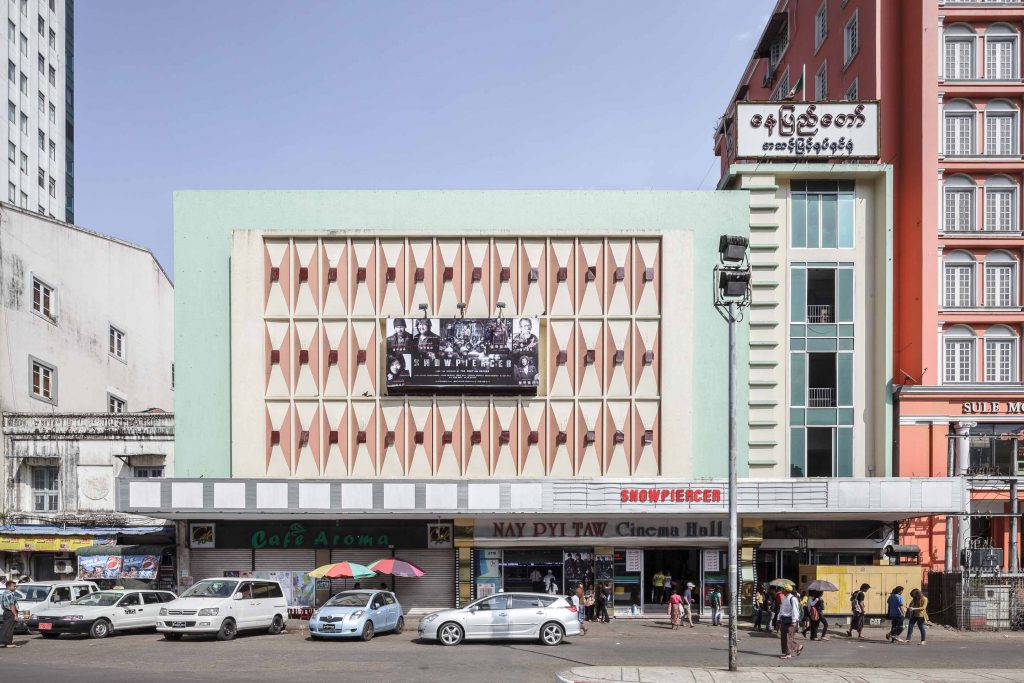
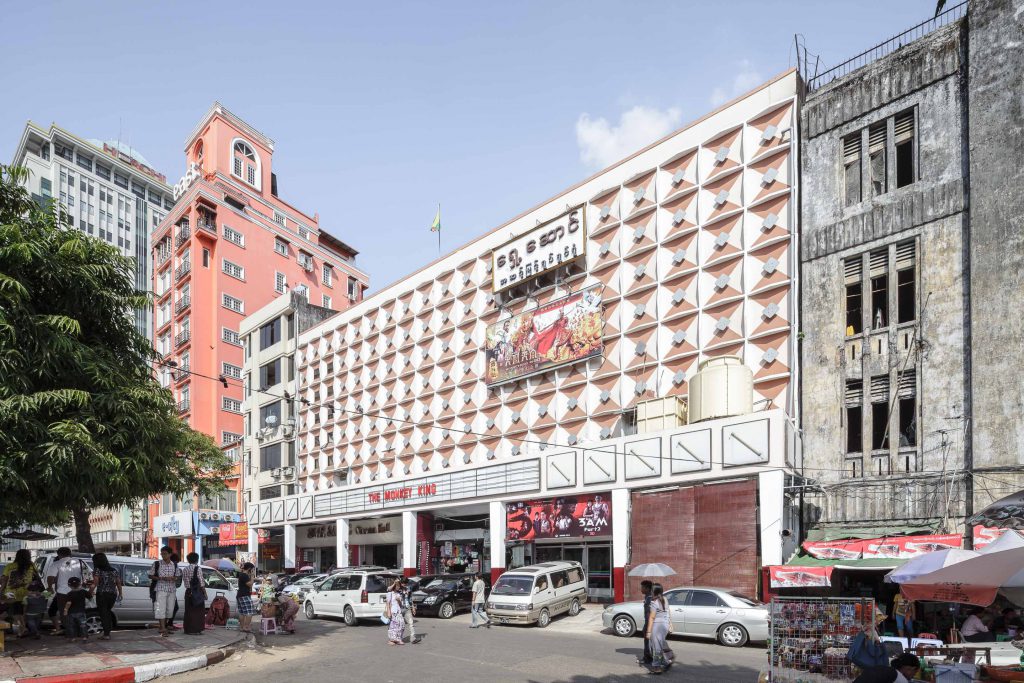
In this movie-mad city, these are popular stomping grounds for Yangon’s young and not-so-young. On any given week, the Nay Pyi Taw and Shae Saung will show the latest Hollywood and local productions. Some Bollywood films are shown here too. Tourists wanting a piece of the action should get there early. As the captivating Southeast Asia Movie Theatre Project describes on its website, upon visiting in 2010:
“[The films here] drew sell-out crowds. Fast-talking ticket scalpers did their dealings just off theatre grounds, selling tickets at inflated prices to those arriving minutes before show time. The mood was electric as hordes of revellers massed at the gates. The chatter, the excitement, the anticipation of escape into a temporary realm of the artificial was unrivalled.”
Both cinemas, like others on this stretch, are owned by the Mingalar Group. The Shae Saung (meaning “Pioneer”, and formerly known as the Lighthouse Cinema) has a capacity of 800. The Nay Pyi Taw holds 400. These are modern alternatives to the charmingly neoclassical Waziya Cinema around the corner.
Central Fire Station
Address: 137–139 Sule Pagoda Road
Year built: 1912
Architect: United Engineers Ltd. (contractors)
Fires were a constant threat throughout the colonial period. While its surviving architectural legacy may suggest otherwise, timber was in fact the dominant building material. Rangoon’s Municipal Committee established a permanent fire brigade in 1883 and motor fire engines were introduced in 1909.
The Central Fire Station on Sule Pagoda Road—still in use today—was built just three years later. Its recognisable octagonal watchtower allowed for panoramic views of the (then relatively low-rise) city. It is set back from the main Sule Pagoda Road on a parallel section of the street. The fire engines park in four bays and have direct access to the thoroughfare. In front of the building is a small stand with a bell struck every half hour. It serves as a clock to those without a watch and still symbolises the fire brigade’s watchful eye over the city.
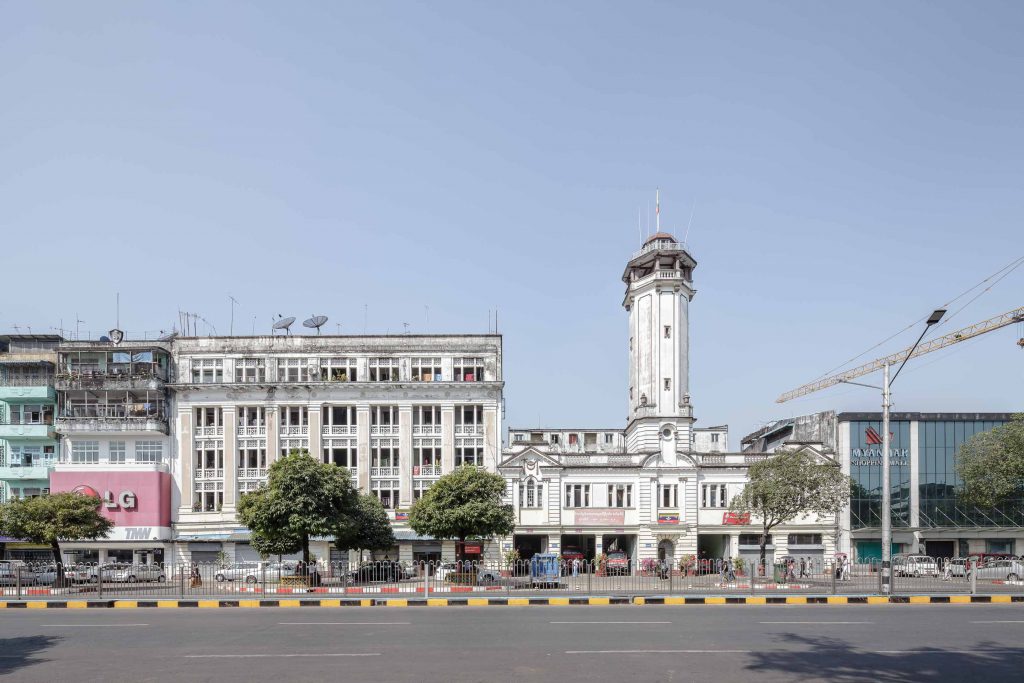
The two-storey building was one of the first iron-frame buildings in colonial Rangoon. It was designed by United Engineers Limited, a company formed by British pioneers Richard Riley and William Hargreaves. The men had business interests across Britain’s colonial possessions in Asia. The company would later become a major Singaporean contractor and remains in the business today.
The glass-fronted building to the right of the fire station used to be the “Diplomatic Stores”, run by the Hotel and Tourism Corporation in the days of Socialist rule. In good socialist fashion, the diplomatic corps could exclusively purchase international luxury goods here in exchange for hard currency, preferably US dollars.
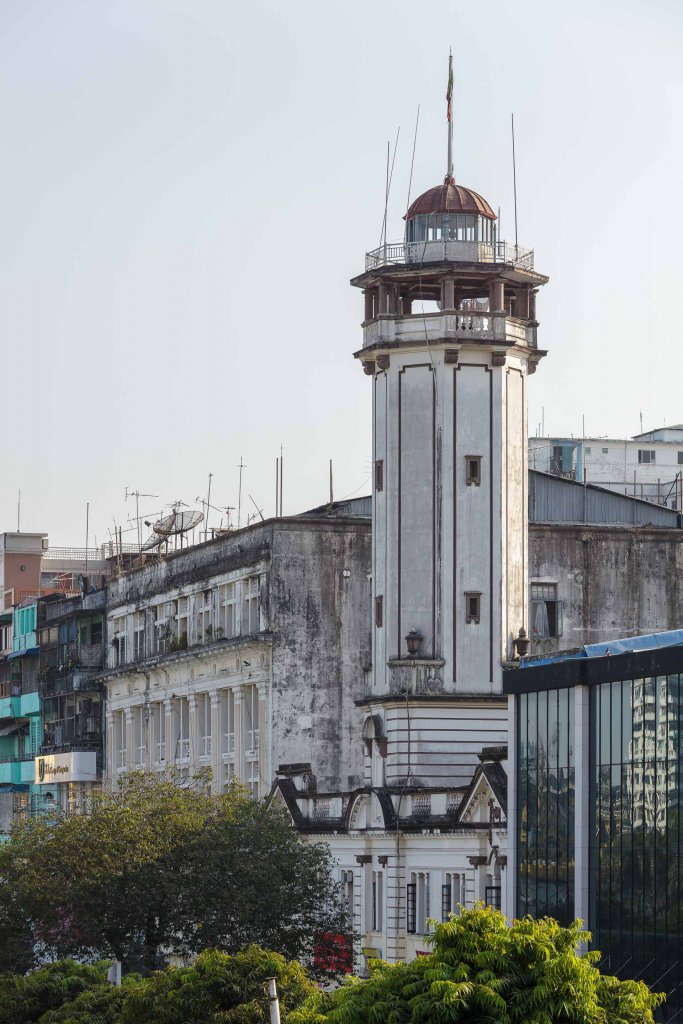
Sunni Jamah Bengali Mosque
Address: 93 Sule Pagoda Road
Year built: 19th century
Architect: Unknown
Given its central location, this mosque is one of Yangon’s largest and most popular. Built in the 19th century, some believe it was founded by immigrants from East Bengal, today’s Bangladesh. Another source states that Bengalis from Calcutta built it and that it was later taken over by the faithful from Chittagong in today’s Bangladesh. The same source holds that this mosque was built as early as 1862. If true, this would refer to an earlier wooden structure, with the masonry building coming later.
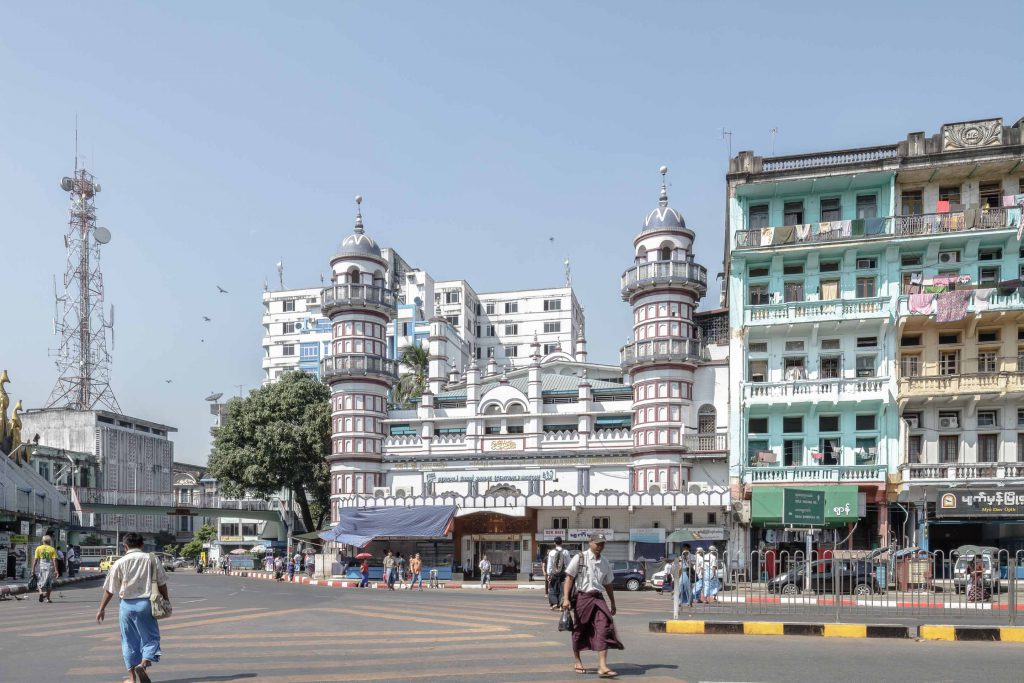
Today, the mosque’s façade is covered with colourful tiles. The minarets overlook the central roundabout next to the Sule Pagoda. (Many of Yangon’s mosques are in good condition. As active places of worship, they are often repainted and refurbished.) An adjacent madrasa offers courses in religion, Arabic and other languages.
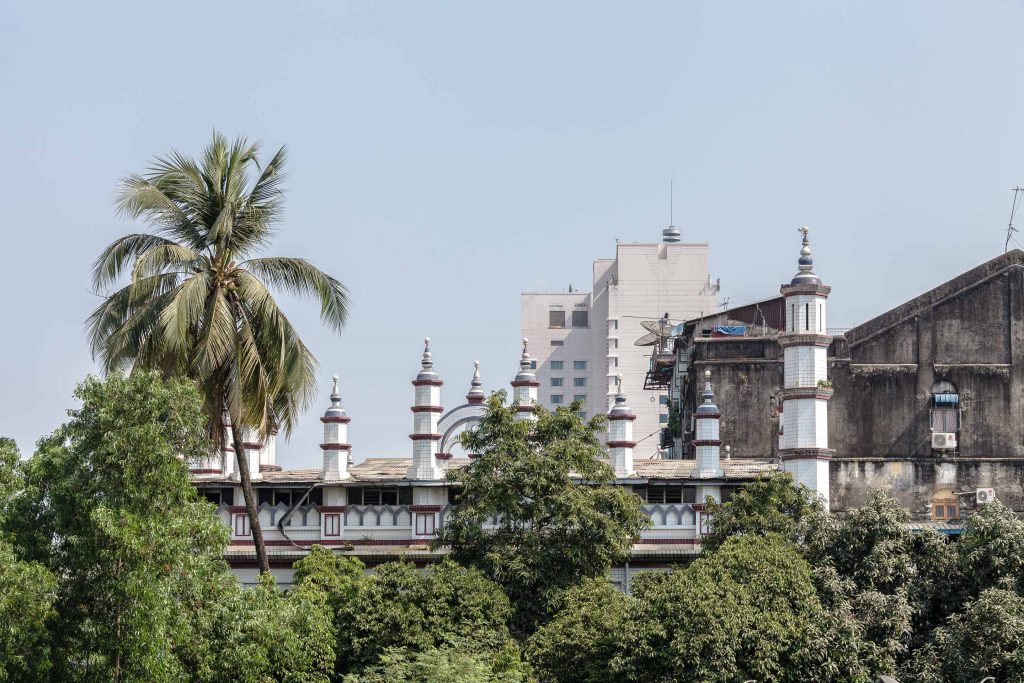
The street in front of the mosque was the site of a rare protest in 2012. About 50 Muslim demonstrators convened here, calling attention to the murder of 10 passengers aboard a bus in Rakhine State. Inter-communal violence between Buddhists and Muslims has flared across the country sporadically. This was especially the case in 2013. Thanks in part to former student leader Mya Aye, a Muslim, the situation in front of the Bengali mosque remained under control. In spite of deadly unrest in other parts of the country, harmonious inter-religious relations have always been one of Yangon’s defining—and inspiring—features.
Sule Pagoda
Address: Sule Pagoda Road / Mahabandoola Road
Year built: 5th century BC
Architect: Unknown
After the Second Anglo–Burmese War in 1852, the British set out to develop Rangoon’s port. Lieutenant Fraser of the Bengal Engineers picked the Sule Pagoda to be the heart of the town’s new street grid. (Fraser also lent his name to nearby Fraser Street, now Anawratha Road.) At that time, the Sule Pagoda stood on an island on the swampy banks of Yangon River, connected to the town by a small wooden bridge. The British drained the shores to establish downtown Yangon as we know it. This puts into perspective the vast challenge posed by some of Yangon’s large colonial constructions. (See for example the Central Telegraph Office, the High Court or St Mary’s Cathedral for other mighty swamp-related challenges.)
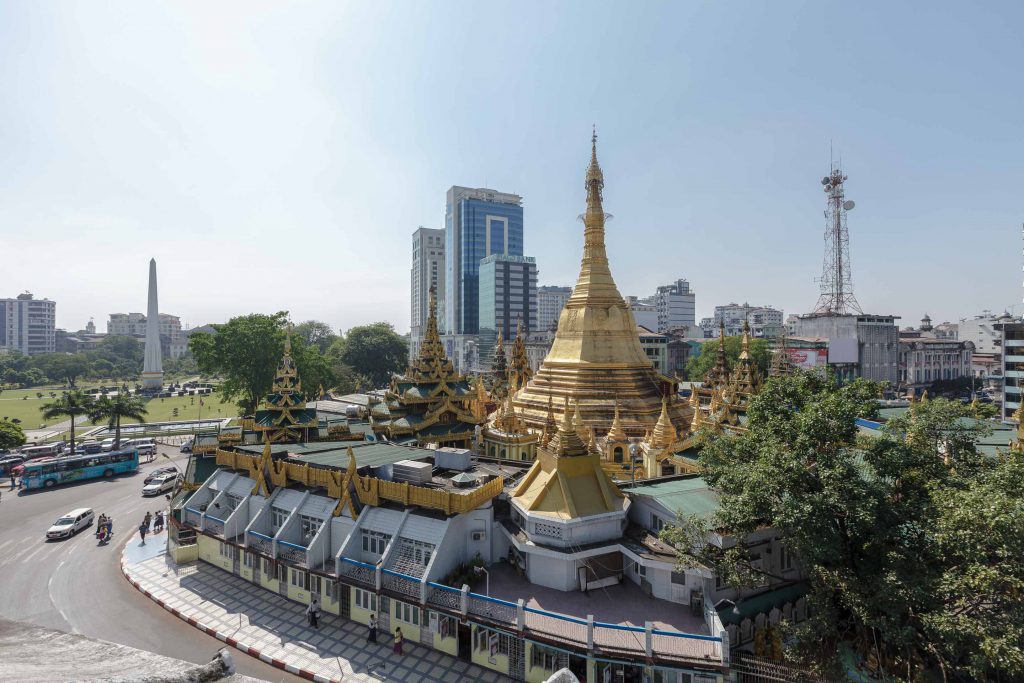
According to Buddhist adage, the Sule Pagoda’s construction dates back to the 5th century BC. However, its stupa is typical of Mon pagoda designs. The Mon spread Theravada Buddhism throughout Southeast Asia and were once among the dominant people in the region—naturally, a source of Mon pride to this day. (Now the Mon occupy Myanmar’s Mon State, whose capital is Mawlamyine, on the country’s southeastern border with Thailand. Like other ethnic armed groups inside the country, the Mon National Liberation Army still skirmishes with the Myanmar military on occasion, although a draft nationwide ceasefire was signed in April 2015.)
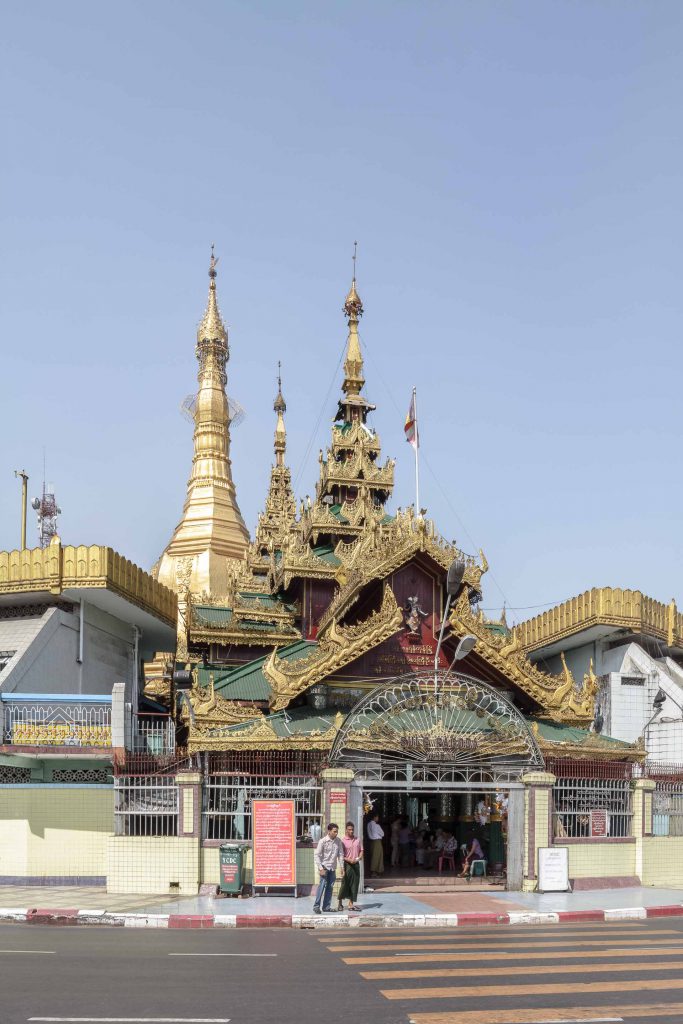
The Sule Pagoda’s Mon name is Kyaik Athok Ceti meaning “stupa where a sacred hair is enshrined”. It is said to be older than the Shwedagon Pagoda. According to legend, it also contains hairs given by the Buddha to merchants Tapussa and Bhallika. King Okkalapa—who, according to the same tale, built the Shwedagon Pagoda to host other strands of those same sacred hairs—ordered the construction of the pagoda in the same place where three previous Buddhas’ relics already lay.
The octagonal stupa has not changed since those ancient times. But today, a ring of modern construction surrounds it. And far from being an oasis of calm, the place is a scramble of shoulders and elbows, chanting and conversation. Meanwhile, Yangon’s increasingly dense traffic grinds its way along the roundabout at its feet.
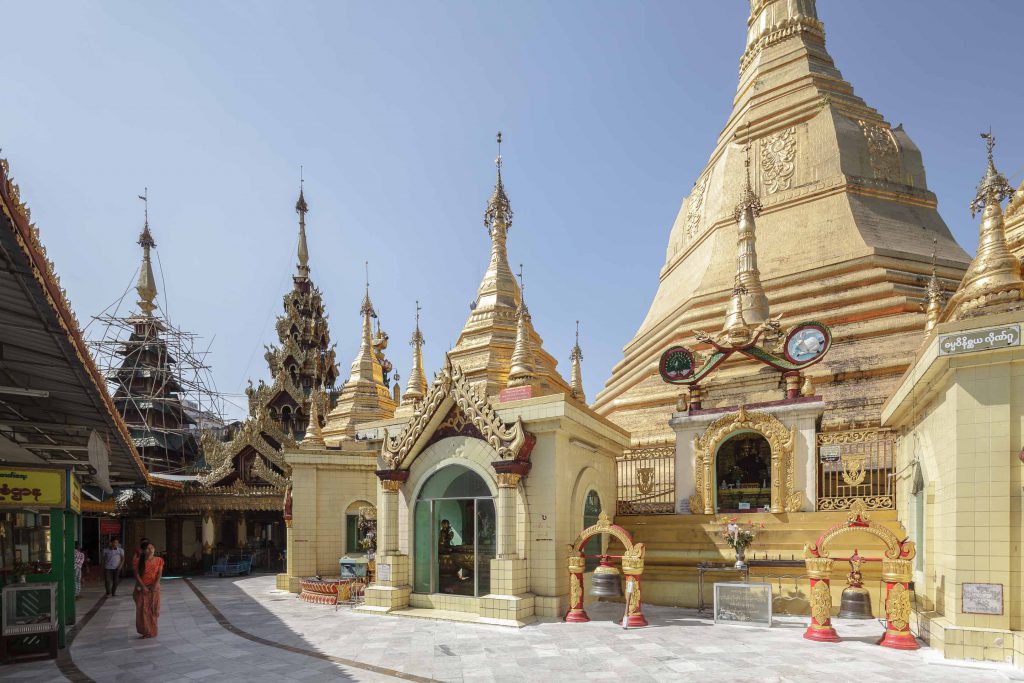
The Sule Pagoda was a frequent and practical rallying space for the country’s uprisings. Major rallies took place there in 1988. It was even more central to the 2007 Saffron Revolution. Up to 50,000 protesters and thousands of robed monks took to the streets in defiance of the regime.
Some of the photos in this section were taken from the pedestrian bridge at the intersection of Sule Pagoda Road and Anawratha Road. These bridges materialised as part of SLORC plans to redesign the city after the 1988 uprisings. (See page 332 for more details on this topic.) The regime thought soldiers could use them to fire down at protesters during future demonstrations. In an ironic twist, some of the Saffron Revolution’s most powerful images were taken from this bridge, which offers an unrivalled view of the Sule Pagoda. A Burmese journalist was on the bridge when he captured footage of a soldier killing Japanese journalist Kenji Nagai. Those images attracted international consternation. Hundreds more died from brutal military repression in these incidents.
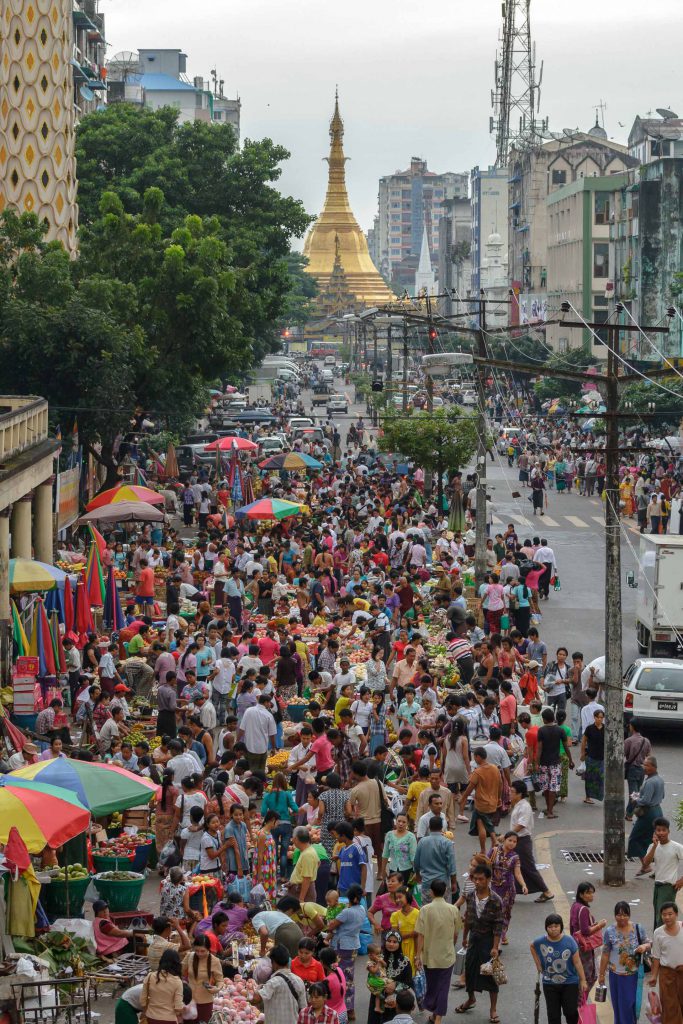
The Sule Pagoda was not always the heart of a city. For much of its existence, it lay on the shores of a quiet town surrounded by swamp water, not honking and screeching cars. The hallowed stupa has never budged of course, and invites us to reflect on the staggering change that led Yangon to what it is today.
Former Ministry of Hotels and Tourism
Formerly: Fytche Square Building
Address: 77–91 Sule Pagoda Road
Year built: 1905
Architect: Thomas Swales
This three-storeyed building is 90 metres wide and displays an impressive, ornate neoclassical façade. It was commissioned by an Indian merchant and later leased to a wealthy Burmese businessman, U Ba Nyunt. He turned it into the first Burmese-run department store, Myanmar Aswe (roughly translating as “Myanmar Friend”). With its prime location on the Sule Pagoda roundabout, this building should have pride of place in the area’s conservation efforts—especially with the next-door Asia Green Development Bank and Centrepoint Towers impinging on the cityscape.
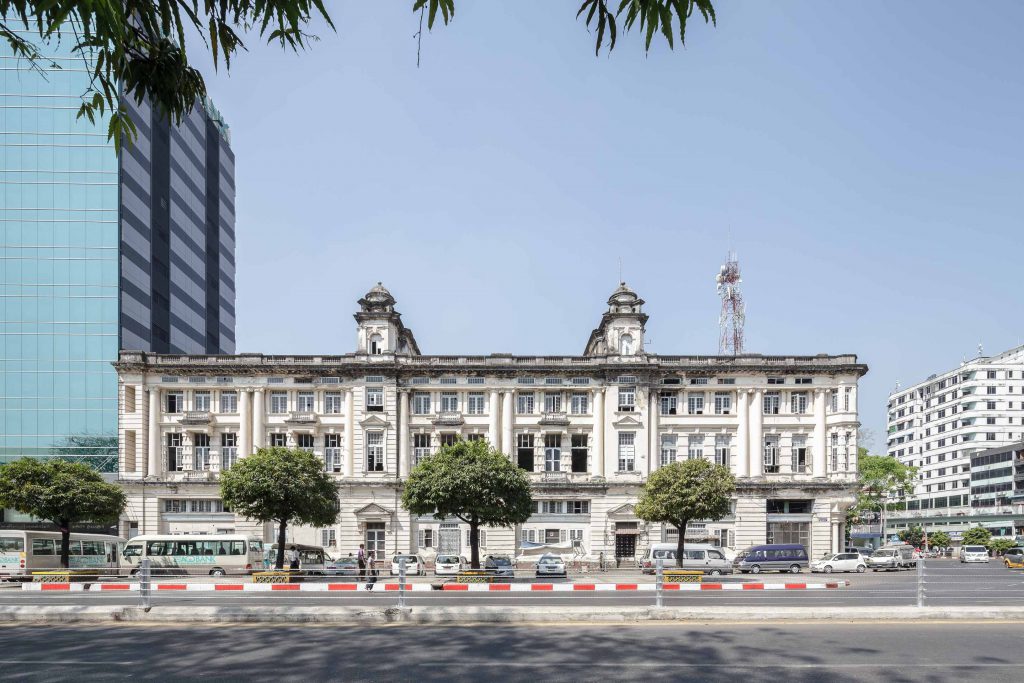
The building’s historical significance is hard to overestimate. Not only was it the first Burmese department store; it also housed the office of the newly established Dagon magazine, a springboard for many famous Burmese writers. The office of one of the first Burmese film studios, the “A1 Film Company” was also here. The company closed down in 1983. (Unfortunately many of its historical documentaries, filmed in the wake of Burmese independence, perished in a fire in 1950.)
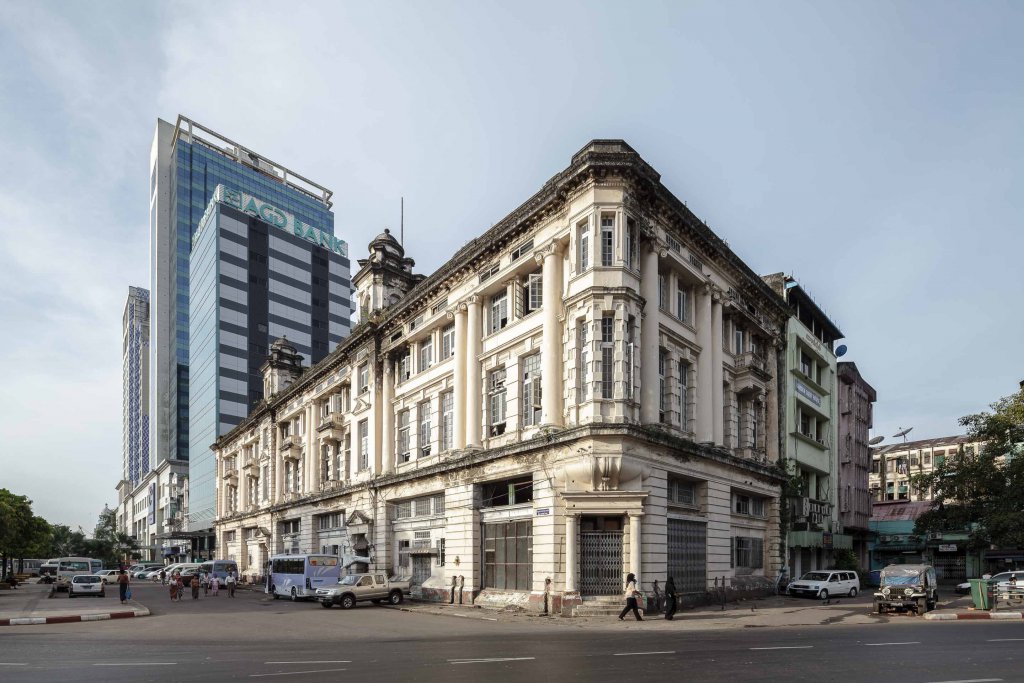
The building was taken over by the government in the 1970s, which coordinated foreign tourism here until the transfer to Naypyidaw in 2005. The building is now almost completely abandoned. It is missing many windows and some of its doors are shuttered.
There was speculation about the building’s future use, from boutique hotel to office space. You will notice emergency repairs, including new roofing and damp protection that took place following the devastating impact of Cyclone Nargis in 2008.
